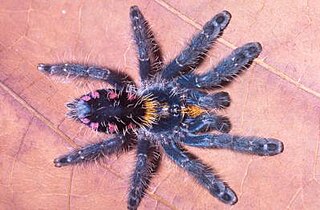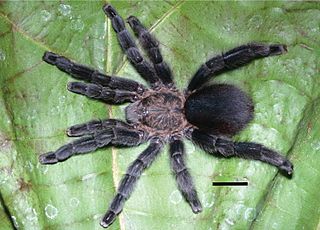
Paraíba is a state of Brazil. It is located in the Brazilian Northeast, and it is bordered by Rio Grande do Norte to the north, Ceará to the west, Pernambuco to the south and the Atlantic Ocean to the east. Paraíba is the third most densely populated state of the Northeast; João Pessoa, the sea-bordered state capital, and Campina Grande, in the interior, rank among the fifteen-largest municipalities in the Northeast of Brazil. The state is home to 1.9% of the Brazilian population and produces 0.9% of the Brazilian GDP.

Areias is a municipality in the state of São Paulo in Brazil. It is part of the Metropolitan Region of Vale do Paraíba e Litoral Norte. The population is 3,896 in an area of 305.23 km². The elevation is 509 m.

Avicularia is a genus of the family Theraphosidae containing various species of tarantulas. The genus is native to tropical Central and South America. Each species in the genus has very distinguishable pink foot pads.

Pamphobeteus is a genus of tarantulas that was first described by Reginald Innes Pocock in 1901. It includes some of the largest spiders in the world.

Tarantulas comprise a group of large and often hairy spiders of the family Theraphosidae. Currently, 1,010 species have been identified. The term "tarantula" is usually used to describe members of the family Theraphosidae, although many other members of the same infraorder (Mygalomorphae) are commonly referred to as "tarantulas" or "false tarantulas". Some of the more common species have become popular in the exotic pet trade. Many New World species kept as pets have setae known as urticating hairs that can cause irritation to the skin, and in extreme cases, cause damage to the eyes.

The skeleton tarantula, Ephebopus murinus, is a species of spider belonging to the family Theraphosidae (tarantulas), sub-family Aviculariinae. A New World species, it is native to several South American countries. Its common name is derived from the skeleton-like markings on its legs.

Pterinopelma sazimai is a species of tarantula. It is known as the Brazilian blue or Sazima's tarantula. Iridescent blue in color, P. sazimai is native to an ecological island within the Chapada Diamantina National Park in Bahia, Brazil. In 2012, it became the first Brazilian species to appear on the International Institute for Species Exploration's Top 10 New Species list. The specific epithet sazimai honors Ivan Sazima, a Brazilian zoologist who was the first to collect exemplars of the species. This species is endangered due to the destruction of its habitat and overcollecting for the illegal pet trade.

Iridopelma is a genus of Brazilian tarantulas that was first described by Reginald Innes Pocock in 1901.

Pachistopelma is a genus of Brazilian tarantulas that was first described by Reginald Innes Pocock in 1901. As of May 2020 it contains two species, found in Brazil: P. bromelicola and P. rufonigrum. They have a straight front eye row and males have a spinose spur on the first tibia. Females have two spermathecae lacking lobes or constrictions that have a slight curvature in the middle.

The Aviculariinae are a subfamily of spiders in the family Theraphosidae (tarantulas). They can be distinguished from other theraphosids by a number of characters. Their legs have no or few spines on the underside of the tibial and metatarsal joints of the legs. The last two leg joints have brushes of hairs (scopulae) that extend sideways, particularly on the front legs, giving them a spoon-like (spatulate) appearance. Females have two completely separated spermathecae.

Typhochlaena is a genus of small-bodied tarantulas with an arboreal trapdoor lifestyle. All the species except for T. seladonia were first described by Rogério Bertani in 2012.
Typhoclaena amma is a species of the Aviculariinae, a subfamily of the Theraphosidae. The specific name refers to the project AMMA – arachnids and myriapods from Brazilian Atlantic rainforest carried out by the arachnologists from Museu Nacional, Rio de Janeiro, who collected the types.

Typhochlaena costae is a species of tarantula in the family Theraphosidae, subfamily Aviculariinae. It is native to Palmas, Tocantins state, Brazil. The species shows an arboreal trapdoor lifestyle.

Typhochlaena paschoali is a species of tarantula, in the subfamily Aviculariinae. It is native to Brazil.

Typhochlaena seladonia is a species of aviculariine tarantula, and is the type species of the genus Typhochlaena. It is unique as an arboreal spider that constructs trapdoors in the bark of trees.

Pachistopelma bromelicola is a species of tarantula, contained within the Aviculariinae subfamily. It is endemic to Brazil.

Pachistopelma rufonigrum is a species of theraphosid, contained within the Aviculariinae subfamily. It is endemic to Brazil.

Pterinopelma is a genus of Brazilian tarantulas that was first described by Reginald Innes Pocock in 1901. As of May 2020 it contains three species, found in Brazil: P. felipeleitei, P. sazimai, and P. vitiosum. It was removed from the synonymy of Eupalaestrus in 2011.

Idiothele mira, also known as the blue-foot baboon or the trap-door tarantula, is a species of tarantula endemic to South Africa and is popularized by hobbyists for the striking blue coloration on the ventral side of the tarsi and metatarsi on each leg. Furthermore, the species is well known for belonging to one of two described genera of theraphosids that build a trapdoor, the other being Typhochlaena.
















